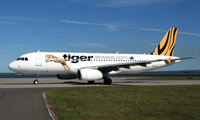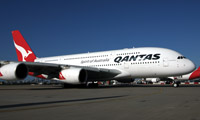News Backgrounder
Borghetti ups the ante
Virgin Australia’s success in winning clearance to take management control of budget carrier, Tiger Airways Australia, and sealing an increased equity deal with major partner, Singapore Airlines, is changing the competitive landscape in Australia - and beyond.
May 1st 2013
For Qantas Airways it was nothing short of a double whammy. Firstly, major rival, Virgin Australia, headed by long-time former Qantas executive, John Borghetti, won approval from the Australian Competition and Consumer Commission (ACCC) to move ahead with its US$35.9 million buy of 60% of budget Tiger Airways Australia. Read More » It was a development that will bring tougher domestic competition for the Flying Kangaroo.
 |
| Virgin Australia chief executive, John Borghetti: facing a tough task with Tiger Airways Australia |
A day later Virgin surprised the market again. This time with an announcement that Singapore Airlines (SIA) was to invest $129.4 million in Virgin Australia increasing its stake in Qantas’ major competitor from 10% to 19.9%.
It is a strategic manoeuvre that strengthens the already firm ties between Virgin and SIA and signals that together they aim to present a powerful partnership to attack Qantas’ troubled international market.
As SIA chief executive, Goh Choon Phong, put it: “Our partnership with Virgin Australia has been going from strength to strength, offering a wide range of consumer benefits.
“Increasing our stake in Virgin Australia is another example of Singapore Airlines’ deep commitment to the important Australian market.
“It also demonstrates our support for the ongoing transformation of Virgin Australia, which has created a more competitive aviation market in Australia.”
SIA initially acquired 10% of Virgin in late 2012. The two airlines have a long-term partnership encompassing code-sharing, reciprocal frequent-flyer programme benefits and lounge access, coordinated schedules to provide seamless connections, and joint sales, marketing and distribution activities.
The big picture is clear. Until now, Virgin has been fighting a lone hand domestically against the combined group operations of Qantas, its big budget airline subsidiary, Jetstar, and its regional offshoot, QantasLink.
 |
| Tiger Airways Australia: now under Virgin Australia management control |
Now, with its own services, low-cost carrier (LCC) Tiger and the recent 100% acquisition of Australian regional Skywest, it can compete on all fronts.
Offshore, with its own virtual alliance that includes SIA, Etihad Airways from Abu Dhabi and Air New Zealand (all have stakes in Virgin), as well as the U.S. carrier, Delta Air Lines, it offers an international network capable of giving Qantas and its new bedfellow, Emirates Airline, a real fight.
The ACCC’s decision on Tiger was close. It was six months in the making and ACCC chairman, Rod Sims, had flagged the possibility he might want guarantees from Virgin regarding fleet growth, a suggestion that raised the hackles of chief executive John Borghetti.
He warned the deal might be abandoned under those circumstances because fleet expansion would depend on market conditions, a situation no airline chief could guarantee.
In the end, the rider was not imposed. What prompted the ACCC to give the green light to the purchase was that Tiger was performing so badly, losing an estimated $61.6 million annually, that without the deal it would have almost certainly ceased operations in Australia. That would have put its 350 staff out of work and forced its 11 A320s to be returned to Tiger’s main Singapore-based Asian operation.
Virgin still has to receive Foreign Investment Review Board (FIRB) approval for the Tiger move, but this is not expected to be a problem.
While it hasn’t guaranteed fleet growth, Virgin, and Tiger’s other investors, have committed to injecting a further $64.1 million into the airline to fund expansion.
This will give it the flexibility to increase the fleet from11 to 35 planes by 2018. It will initially add 12 A320s.
 |
| Qantas Airways: facing stiff competition at home and abroad |
Borghetti said the deal provided an opportunity to deliver strong competition in the budget travel segment.
“By partnering with Tiger Airways we can use our local expertise to build a sustainable budget carrier, which will offer great value airfares and benefit jobs and tourism in Australia,” he said.
He faces a tough task. Tiger has the lowest airline cost base in Australia, but it also has the worst reputation.
Apart from safety issues – failures in its safety systems led to Tiger being grounded in 2011 – it has been repeatedly criticized for poor service levels and cancelled and late flights.
Analysts at Macquarie Equity in Sydney said Virgin will have its work cut out turning Tiger around.
“The key outcomes for a turn-around in Tiger’s profitability will be a focus on safety, on-time performance and a renewed effort in marketing,” they said.
“Management will need to move quickly to establish the new carrier in the market and stem the current losses.”
Nevertheless, many other analysts are more optimistic, suggesting that Borghetti’s track record in moving Virgin from its early guise as a budget carrier to a high-quality, full-service operator and his proven ability to attract major investors to back his plans bodes well.
 |
| 'Our partnership with Virgin Australia has been going from strength to strength' |
| Goh Choon Phong Chief Executive Singapore Airlines |
His creation of a virtual global airline alliance is part of the significant changes taking place in the Asia-Pacific aviation landscape. They include changing legacy airline strategies, such as Qantas’ new partnership with Emirates, SIA taking the unprecedented step of launching a long-haul, low-cost carrier, Scoot, and the rapid growth of the budget sector, including the emergence of LCCs in Japan.
Apart from Scoot, AirAsia’s long-haul arm, AirAsiaX, is being joined by carriers aiming to take the no-frills offering beyond short and regional routes.
Last month, for example, the Philippines’ Cebu Pacific, which already flies to 20 international destinations, including four in China (Hong Kong and Macau would make six), announced its first long-haul service, to Dubai in the United Arab Emirates.
The flights, using A330s configured with more than 400 all-economy seats, will begin in October.
The carrier previously announced it would lease up to eight A330-300s – taking delivery of two this year and another two next – that could serve markets such as Australia, the Middle East, parts of Europe and the U.S.